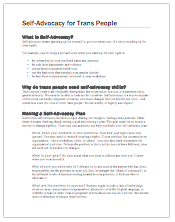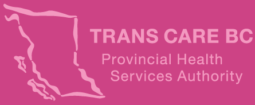
What is Self-Advocacy?
Self-advocacy means speaking up for yourself to get your needs met. It’s about standing up for your rights.
For example, you’re being a self-advocate when you stand up for your right to:
- be referred to by your preferred name and pronoun
- be safe from harassment and violence
- access trans-competent health care
- use the bathroom that matches your gender identity
- be free from discriminatory treatment in your workplace
Why do trans people need self-advocacy skills?
Trans people’s rights are frequently disregarded due to prejudice or a lack of awareness about gender diversity. We need to be able to look out for ourselves. Self-advocacy is a way to educate others about our needs, empower ourselves, and make changes that can benefit our lives – and sometimes even the lives of other trans people. We are worthy of dignity and respect.
Making a Self-Advocacy Plan
Sometimes self-advocacy involves simply sharing our thoughts, feelings and questions. Other times it means thinking ahead, setting a goal and making a plan. The goal might be to access a service or change a policy. These tips and questions can help you build your self-advocacy plan:
Write down your problem in one sentence. State how your rights have been ignored. You may need to research your legal rights. If your problem has occurred in an organization – like a workplace, clinic, or school – you may also need to research the organization’s policies. Perhaps the problem is that a policy has not been followed, does not exist yet, or needs to be changed.
What is your goal? Be clear about what you want to achieve and how you’ll know when you’ve achieved it.
Who should you advocate to? Always try to advocate to the person who has direct responsibility for the problem or issue you face. Investigate the “chain of command”, or the different levels of decision-making related to your problem, to find out who to advocate to.
What are the barriers to success? Barriers might include a lack of knowledge about an issue, inexperience being assertive, discomfort with the English language, or inability to read or write. Fear of judgment or retaliation can also be a barrier. Brainstorm ideas to eliminate or reduce these barriers.
What strategies and resources can you use to make your advocacy efforts effective?
- Collect documentation that will help communicate the problem you’re facing. This documentation could include forms or letters. It may involve contacting other people, such as doctors or support workers to pull together information that illustrates the problem.
- Gather your documentation, organize it, and keep it together for easy reference.
- Keep a log of people and programs you’ve contacted. In the log, include dates, contact information and responses.
- Decide whether to advocate by writing a letter, sending email, making a phone call, or booking an appointment.
- Identify people who can support you in your advocacy efforts. This might include family, friends, elected officials, advocacy groups, or peer-to-peer support groups.
What will you do if this plan doesn’t work out? It’s a good idea to plan for positive and negative outcomes. If your first try is unsuccessful, are there alternate solutions you are willing to explore? Are you willing to change your goals or try a new strategy? Could you advocate to different people or draw on different people or resources for support? Staying positive is important, and so is being prepared.
Communication Styles
As self-advocates, we need to be able to express our needs using a communication style that is likely to facilitate a helpful response. People use different communication styles in different situations. It is helpful to think about what style of communication is likely to be effective as you advocate for your rights.
A passive communication style: avoiding expressing opinions, feelings or needs, which may allow others to infringe on our rights.
An aggressive communication style: expressing opinions, feelings and needs in a way that promotes our own rights but disregards others’ rights.
A passive-aggressive communication style: appearing passive on the surface, but acting out anger behind-the-scenes, without clearly expressing our opinions, feeling or needs.
A manipulative communication style: trying to control others to our own advantage, for example, getting our needs met by making others feel guilty or sorry for us.
An assertive communication style: clearly stating opinions, feeling and needs, and advocating for rights while respecting other’s rights. Being assertive is most likely to facilitate a favourable response from those with the authority.
Tips for Assertive Communication
Communicating the problem
Share observations of the problem that are specific to time and place. This helps avoid making generalizations, which can be proven wrong and make you seem less credible.
✓ “You referred to me with the wrong pronoun at my appointment yesterday and last week.”
✗ “You always refer to me with the wrong pronoun.”
Express your needs rather than judgments about the person or organization you are having the problem with. When people hear criticism they are more likely to resist what you are saying.
✓ “I need my identity to be acknowledged and affirmed. Pronouns are an important part of that.”
✗ “You’re being ignorant and insensitive when you use the wrong pronoun.”
Making requests
Use positive language. Ask for what you want, rather than what you don’t want. This prevents confusion.
✓ “Use they, them and their when you refer to me.”
✗ “Don’t refer to me as he.”
Be clear and concrete about what you want, rather than vague and abstract. This prevents confusion.
✓ “It’s respectful to use they, them and their when you refer to me.”
✗ “Please be respectful.”
Make requests, not demands. It’s a request if you show empathy for the other person’s needs when they do not comply. People will be more likely to empathize with us if we empathize with them. It’s a demand if the listener will be blamed, punished or guilt-tripped for not complying. When people hear demands, they tend to respond by submitting or rebelling – both of which can damage the relationship, making it difficult to resolve problems in the future.
✓ “I know gender neutral pronouns are new for you and you are finding this difficult. Please make an effort to learn to use language that respects my identity.”
Make sure the person understands your request. Clarifying right away saves time.
✓ Sometimes it’s enough to ask, “Is that clear?” Other times, we may ask, “Would you be willing to repeat what you heard me say, to help avoid misunderstandings?”
If the person dismisses your request, ask them what they would suggest. If their suggestion does not meet your needs, give clear reasons why. This actively involves the other person in generating solutions.
Active listening
- Listen carefully and try to understand the other person’s. Typically, the more we hear the person we are communicating with, the more they will hear us.
- Clarify what you hear by repeating it back. Say things like “Let me see if I understand what you’re saying…” or “You’re saying… Do I have that right?”
- Be aware of your body language. Make eye contact and speak clearly, calmly, and audibly. Take a posture that shows you are trying to listen and understand.
- Listen for what needs the person or organization has and look for solutions that have mutual gains. This might involve thinking outside of the box to generate a variety of solutions, rather than focusing on just one.
- Stay connected to the needs of others. Communicate in a way that shows you are equally concerned about the needs of others being met. People are more likely to empathize about our needs if we empathize with theirs.
Managing your emotions
- Practice being aware of how you’re feeling. When our needs aren’t being met, these are some of the things we might feel: afraid, annoyed, confused, disconnected, embarrassed, tired, pain, sad, tense, vulnerable, disturbed, or longing.
- Connect your feeling to what you need. Here are some common needs: connection, belonging, love, appreciation, physical well-being, honesty, joy, humour, equality, beauty, choice, freedom, challenge, growth, and learning. Make requests based on what you need.
- Anger can be a valuable alarm for alerting us that our needs are not being met. It is also a signal that we are thinking in a way that may make it difficult to communicate about our needs.
- When you feel angry, stop and breathe. If you can, identify what is causing the anger and what needs are not being met. Finally, express your needs. These steps help you channel your anger toward getting your needs met without being aggressive. (This skill takes a lot of practice to learn!)
- If you are having difficulty managing your anger or are feeling withdrawn, ask for some time to reflect on what has been discussed and arrange a time to meet again later.
Are there times when I should not self-advocate?
Yes. Don’t self-advocate if:
- you don’t feel safe
- you’re too angry to be assertive instead of aggressive
There are many options for protecting your rights aside from self-advocacy. (See below).
Alternatives to Self-Advocacy
- Ask a friend or family member to advocate on your behalf.
- Find an organization with professional advocates who have experience related to your problem.
- Hire a lawyer. If you cannot afford a lawyer, consult organizations that do pro-bono (free) legal work.
- Contact the office of your city councilor, MLA or MP, if some level of government is responsible for your issue. You can contact an Ombudsperson at the same time. Ask them advocate on your behalf.
- Support or create a group that works to create progressive systemic change.




